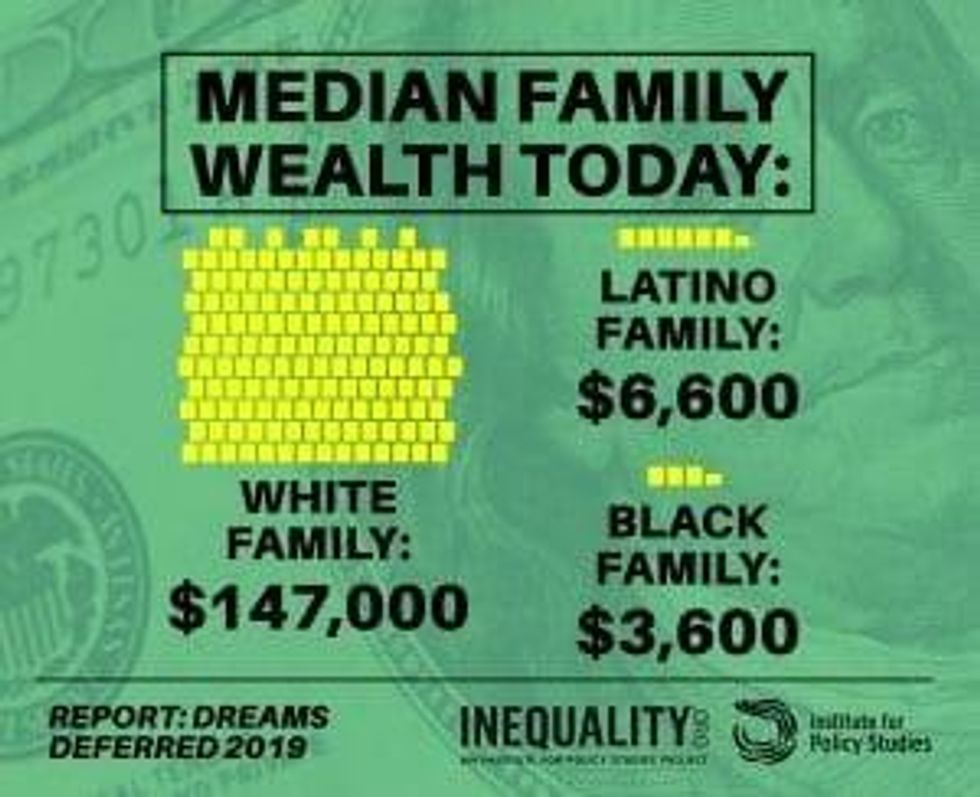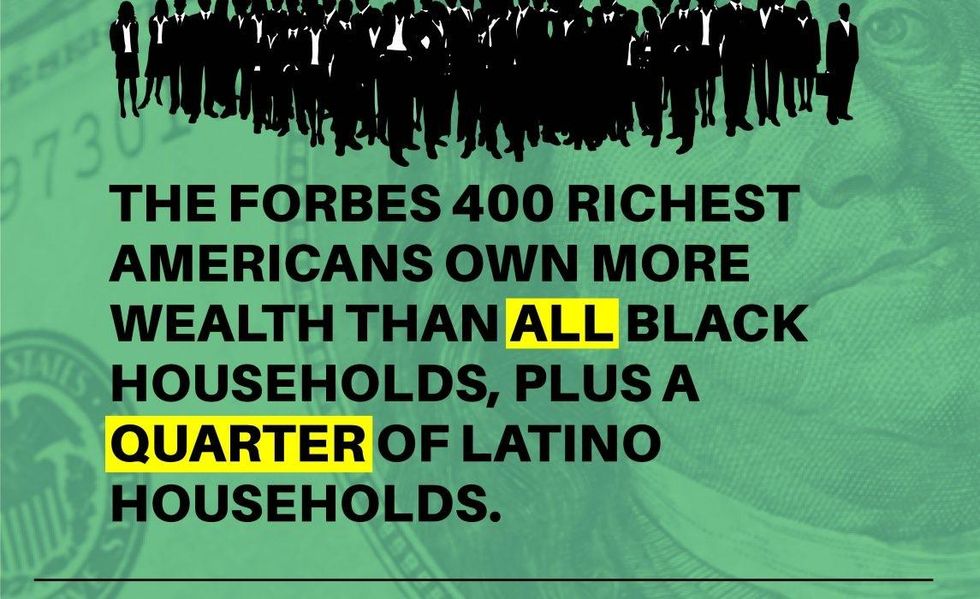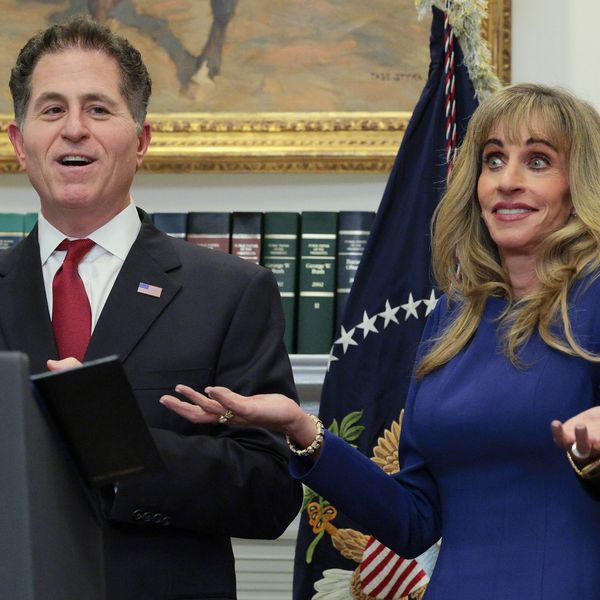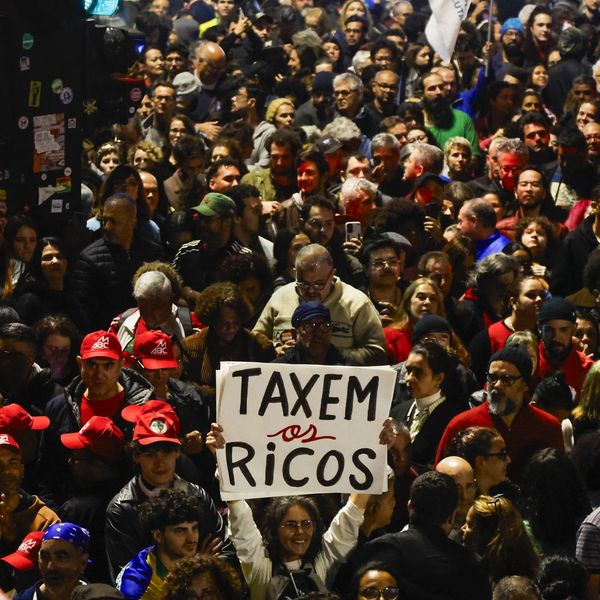
The widening of the racial wealth divide has coincided with the extreme concentration of U.S. wealth. The wealthiest 0.1 percent of households have grown richer while millions of families face poverty and deep-seated economic insecurity. (Image: Inequality.org / Institute for Policy Studies)
Dreams Deferred: How Enriching the 1 Percent Widens the Racial Wealth Divide
Our new report highlights how a polarizing racial wealth divide has grown between White households and households of color over the past three decades
January 15, 2019, the release date of this report, would have been the 90th birthday of Dr. Martin Luther King, Jr. Dr. King envisioned a future in which deep racial inequalities were eradicated and he worked tirelessly towards that mission. His tragic assassination occurred while he was organizing the Poor Peoples Campaign, his last great effort to ensure economic justice as a cornerstone of civil rights.
In light of Dr. King's pursuit of economic justice, this report highlights how historic racial wealth disparities have been perpetuated and increased by the trend towards extreme inequality in the United States. It also puts the racial wealth divide in the context of overall wealth inequality trends.

Key Findings
This report looks at the trends in household wealth among Black, Latino and White households over the past three decades. It relies on data from the Federal Reserve Board's most recent triannual Survey of Consumer Finances. The Racial Wealth Divide Over the past three decades, a polarizing racial wealth divide has grown between White households and households of color. Since the early 1980s, median wealth among Black and Latino families has been stuck at less than $10,000. Meanwhile, White household median wealth grew from $105,300 to $140,500, adjusting for inflation.
The Racial Wealth Divide
Over the past three decades, a polarizing racial wealth divide has grown between White households and households of color. Since the early 1980s, median wealth among Black and Latino families has been stuck at less than $10,000. Meanwhile, White household median wealth grew from $105,300 to $140,500, adjusting for inflation.
- Between 1983 and 2016, the median Black family saw their wealth drop by more than half after adjusting for inflation, compared to a 33 percent increase for the median White household. Over that same period, the number of households with $10 million or more skyrocketed by 856 percent.
- The median Black family today owns $3,600-- just 2 percent of the $147,000 of wealth the median White family owns. The median Latino family has assets worth $6,600 -- just 4 percent as much as the median White family. In other words, the median White family has 41 times more wealth than the median Black family and 22 times more wealth than the median Latino family.
- If the trajectory of the past three decades continues, by 2050 the median White family will have $174,000 of wealth, while Latino median wealth will be $8,600 and Black median wealth will be $600. The median Black family is on track to reach zero wealth by 2082.
- If current trends continue, it would take the typical Black family over 52 million years to reach the wealth of the Walton family today and Latino families 24 million years.
- The proportion of all U.S. households with zero or "negative" wealth, meaning their debts exceed the value of their assets, has grown from 1 in 6 in 1983 to 1 in 5 households today. Families of color are much likelier to be in this precarious financial situation. Thirty-seven percent of Black families and 33 percent of Latino families have zero or negative wealth, compared to just 15.5 percent of White families. One piece of good news: the proportion of Latino families with zero or negative net worth dropped 19 percent between 1983 and 2016, from 40 percent to 33 percent.
- Black families are about 20 times more likely to have zero or negative wealth (37 percent) than they are to have $1 million or more in assets (1.9 percent). Latino families are 14 times more likely to have zero or negative wealth (32.8 percent) than they are to reach the millionaire threshold (2.3 percent). White families are equally likely to have zero or negative wealth (about 15 percent) as they are to be a millionaire (15 percent).
- Low levels of Black and Latino wealth, combined with their growing proportion of the population, is a key factor in the overall decline in American median household wealth from $84,111 in 1983 to $81,704 in 2016.
In a Deeply Unequal Economy
The widening of the racial wealth divide has coincided with the extreme concentration of U.S. wealth. The wealthiest 0.1 percent of households have grown richer while millions of families face poverty and deep-seated economic insecurity.
- The median American family saw their wealth drop 3 percent between 1983 and 2016, while the richest 0.1 percent have seen their wealth jump 133 percent.
- During this same period, the annual increase for White median family wealth was about $1,000. Latino median family wealth went up by $66 annually and Black median family wealth dropped $83 annually. Meanwhile, the average household in the top 1 percent saw their wealth jump by half a million dollars annually.
- The richest dynastic families in the United States have seen their wealth expand at a dizzying pace. The three wealthiest families -- the Waltons, the Kochs, and the Mars -- have seen their wealth increase nearly 6,000 percent since 1983.
- The Forbes 400 richest Americans own more wealth than all Black households plus a quarter of Latino households.
- Jeff Bezos, founder of Amazon, owns $160 billion in total wealth. That is 44 million times more wealth than the median Black family and 24 million times more wealth than the median Latino family.

Moving Forward
The racial wealth divide and growing economic inequality is often analyzed as two separate and concurrent trends, when in fact, they are mutually reinforcing outcomes of larger economic issues. Both the racial wealth divide and the unequal economy were created and perpetuated by public policies that favored Whites and continue to favor the very wealthy. Public policies aimed at reducing both trends will be critical to creating a more equitable economic system and a more just society overall. Such policies could include, but are not limited to:
- A baby bond program to help low-wealth households build wealth
- A tax on the wealthiest 0.1 percent to reduce distortions caused by concentrated wealth and generate revenue marked for expanding opportunity for low-wealth households
- An audit of federal government policies to evaluate their impact on the racial wealth divide
- Targeted reparations to address the legacy of racism in wealth building
Dreams Deferred expands on and updates two previous reports from the Program on Inequality and the Common Good at the Institute for Policy Studies, in collaboration with Prosperity Now: "The Ever-Growing Gap: Failing to Address the Status Quo Will Drive the Racial Wealth Divide for Centuries to Come," in 2016, and "The Road to Zero Wealth: How the Racial Wealth Divide is Hollowing Out America's Middle Class" in 2017. This report also builds on extensive research on the growing concentration of wealth in the United States catalogued in the "Billionaire Bonanza" report series released in 2015, 2017, and 2018. The most recent edition focused on the growing power and influence of intergenerational wealth dynasties.
Too often Dr. King's "Dream" of making justice a reality for people of color is conflated with the "fantasy of self-deception" that there is "steady growth toward a middle-class utopia." Examining the concentration of wealth and ongoing deep racial wealth inequality in light of Dr. King's 90th birthday reminds us of the reality King spoke of in his famous "I Have A Dream Speech": "the Negro lives on a lonely island of poverty in the midst of a vast ocean of material prosperity."
Dr. King also stated in this speech that "America has given the Negro people a bad check, a check which has come back marked 'insufficient funds." Over 50 years since this famous dream was shared with the nation, we have seen wealth concentrate among the wealthiest Americans and a polarizing racial wealth divide grow between Whites and Blacks and Latinos.
Despite aspirant rhetoric and sensationalized media stories, the racial wealth divide has not improved over the past three decades. In fact, the divide has grown considerably as wealth continues to concentrate at the top leaving the rest of the country an increasingly smaller share. A targeted set of policies is imperative to begin to bridge this deep divide for generations to come. Inaction or, worse, repeating the same mistakes that led to this situation will simply widen further the divide and create greater economic instability for the country at large.
An Urgent Message From Our Co-Founder
Dear Common Dreams reader, The U.S. is on a fast track to authoritarianism like nothing I've ever seen. Meanwhile, corporate news outlets are utterly capitulating to Trump, twisting their coverage to avoid drawing his ire while lining up to stuff cash in his pockets. That's why I believe that Common Dreams is doing the best and most consequential reporting that we've ever done. Our small but mighty team is a progressive reporting powerhouse, covering the news every day that the corporate media never will. Our mission has always been simple: To inform. To inspire. And to ignite change for the common good. Now here's the key piece that I want all our readers to understand: None of this would be possible without your financial support. That's not just some fundraising cliche. It's the absolute and literal truth. We don't accept corporate advertising and never will. We don't have a paywall because we don't think people should be blocked from critical news based on their ability to pay. Everything we do is funded by the donations of readers like you. Will you donate now to help power the nonprofit, independent reporting of Common Dreams? Thank you for being a vital member of our community. Together, we can keep independent journalism alive when it’s needed most. - Craig Brown, Co-founder |
Chuck Collins is a senior scholar at the Institute for Policy Studies where he co-edits Inequality.org. His near future novel "Altar to An Erupting Sun” explores one community’s response to climate disruption. He is author of numerous books and reports on inequality and the racial wealth divide, including “The Wealth Hoarders: How Billionaires Spend Millions to Hide Trillions,” “Born on Third Base,” and, with Bill Gates Sr., of “Wealth and Our Commonwealth: Why American Should Tax Accumulated Fortunes.” See more of his writing at www.chuckcollinswrites.com
January 15, 2019, the release date of this report, would have been the 90th birthday of Dr. Martin Luther King, Jr. Dr. King envisioned a future in which deep racial inequalities were eradicated and he worked tirelessly towards that mission. His tragic assassination occurred while he was organizing the Poor Peoples Campaign, his last great effort to ensure economic justice as a cornerstone of civil rights.
In light of Dr. King's pursuit of economic justice, this report highlights how historic racial wealth disparities have been perpetuated and increased by the trend towards extreme inequality in the United States. It also puts the racial wealth divide in the context of overall wealth inequality trends.

Key Findings
This report looks at the trends in household wealth among Black, Latino and White households over the past three decades. It relies on data from the Federal Reserve Board's most recent triannual Survey of Consumer Finances. The Racial Wealth Divide Over the past three decades, a polarizing racial wealth divide has grown between White households and households of color. Since the early 1980s, median wealth among Black and Latino families has been stuck at less than $10,000. Meanwhile, White household median wealth grew from $105,300 to $140,500, adjusting for inflation.
The Racial Wealth Divide
Over the past three decades, a polarizing racial wealth divide has grown between White households and households of color. Since the early 1980s, median wealth among Black and Latino families has been stuck at less than $10,000. Meanwhile, White household median wealth grew from $105,300 to $140,500, adjusting for inflation.
- Between 1983 and 2016, the median Black family saw their wealth drop by more than half after adjusting for inflation, compared to a 33 percent increase for the median White household. Over that same period, the number of households with $10 million or more skyrocketed by 856 percent.
- The median Black family today owns $3,600-- just 2 percent of the $147,000 of wealth the median White family owns. The median Latino family has assets worth $6,600 -- just 4 percent as much as the median White family. In other words, the median White family has 41 times more wealth than the median Black family and 22 times more wealth than the median Latino family.
- If the trajectory of the past three decades continues, by 2050 the median White family will have $174,000 of wealth, while Latino median wealth will be $8,600 and Black median wealth will be $600. The median Black family is on track to reach zero wealth by 2082.
- If current trends continue, it would take the typical Black family over 52 million years to reach the wealth of the Walton family today and Latino families 24 million years.
- The proportion of all U.S. households with zero or "negative" wealth, meaning their debts exceed the value of their assets, has grown from 1 in 6 in 1983 to 1 in 5 households today. Families of color are much likelier to be in this precarious financial situation. Thirty-seven percent of Black families and 33 percent of Latino families have zero or negative wealth, compared to just 15.5 percent of White families. One piece of good news: the proportion of Latino families with zero or negative net worth dropped 19 percent between 1983 and 2016, from 40 percent to 33 percent.
- Black families are about 20 times more likely to have zero or negative wealth (37 percent) than they are to have $1 million or more in assets (1.9 percent). Latino families are 14 times more likely to have zero or negative wealth (32.8 percent) than they are to reach the millionaire threshold (2.3 percent). White families are equally likely to have zero or negative wealth (about 15 percent) as they are to be a millionaire (15 percent).
- Low levels of Black and Latino wealth, combined with their growing proportion of the population, is a key factor in the overall decline in American median household wealth from $84,111 in 1983 to $81,704 in 2016.
In a Deeply Unequal Economy
The widening of the racial wealth divide has coincided with the extreme concentration of U.S. wealth. The wealthiest 0.1 percent of households have grown richer while millions of families face poverty and deep-seated economic insecurity.
- The median American family saw their wealth drop 3 percent between 1983 and 2016, while the richest 0.1 percent have seen their wealth jump 133 percent.
- During this same period, the annual increase for White median family wealth was about $1,000. Latino median family wealth went up by $66 annually and Black median family wealth dropped $83 annually. Meanwhile, the average household in the top 1 percent saw their wealth jump by half a million dollars annually.
- The richest dynastic families in the United States have seen their wealth expand at a dizzying pace. The three wealthiest families -- the Waltons, the Kochs, and the Mars -- have seen their wealth increase nearly 6,000 percent since 1983.
- The Forbes 400 richest Americans own more wealth than all Black households plus a quarter of Latino households.
- Jeff Bezos, founder of Amazon, owns $160 billion in total wealth. That is 44 million times more wealth than the median Black family and 24 million times more wealth than the median Latino family.

Moving Forward
The racial wealth divide and growing economic inequality is often analyzed as two separate and concurrent trends, when in fact, they are mutually reinforcing outcomes of larger economic issues. Both the racial wealth divide and the unequal economy were created and perpetuated by public policies that favored Whites and continue to favor the very wealthy. Public policies aimed at reducing both trends will be critical to creating a more equitable economic system and a more just society overall. Such policies could include, but are not limited to:
- A baby bond program to help low-wealth households build wealth
- A tax on the wealthiest 0.1 percent to reduce distortions caused by concentrated wealth and generate revenue marked for expanding opportunity for low-wealth households
- An audit of federal government policies to evaluate their impact on the racial wealth divide
- Targeted reparations to address the legacy of racism in wealth building
Dreams Deferred expands on and updates two previous reports from the Program on Inequality and the Common Good at the Institute for Policy Studies, in collaboration with Prosperity Now: "The Ever-Growing Gap: Failing to Address the Status Quo Will Drive the Racial Wealth Divide for Centuries to Come," in 2016, and "The Road to Zero Wealth: How the Racial Wealth Divide is Hollowing Out America's Middle Class" in 2017. This report also builds on extensive research on the growing concentration of wealth in the United States catalogued in the "Billionaire Bonanza" report series released in 2015, 2017, and 2018. The most recent edition focused on the growing power and influence of intergenerational wealth dynasties.
Too often Dr. King's "Dream" of making justice a reality for people of color is conflated with the "fantasy of self-deception" that there is "steady growth toward a middle-class utopia." Examining the concentration of wealth and ongoing deep racial wealth inequality in light of Dr. King's 90th birthday reminds us of the reality King spoke of in his famous "I Have A Dream Speech": "the Negro lives on a lonely island of poverty in the midst of a vast ocean of material prosperity."
Dr. King also stated in this speech that "America has given the Negro people a bad check, a check which has come back marked 'insufficient funds." Over 50 years since this famous dream was shared with the nation, we have seen wealth concentrate among the wealthiest Americans and a polarizing racial wealth divide grow between Whites and Blacks and Latinos.
Despite aspirant rhetoric and sensationalized media stories, the racial wealth divide has not improved over the past three decades. In fact, the divide has grown considerably as wealth continues to concentrate at the top leaving the rest of the country an increasingly smaller share. A targeted set of policies is imperative to begin to bridge this deep divide for generations to come. Inaction or, worse, repeating the same mistakes that led to this situation will simply widen further the divide and create greater economic instability for the country at large.
- Opinion | 60 Years After the March on Washington, the Black-White Wealth Gap Is Still Too Wide | Common Dreams ›
- Opinion | On MLK’s 95th Birthday, the Check for Racial Economic Equality Is Still Bouncing | Common Dreams ›
- Opinion | ‘Baby Bonds’ Can Help Democratize the Stock Market, for Real | Common Dreams ›
Chuck Collins is a senior scholar at the Institute for Policy Studies where he co-edits Inequality.org. His near future novel "Altar to An Erupting Sun” explores one community’s response to climate disruption. He is author of numerous books and reports on inequality and the racial wealth divide, including “The Wealth Hoarders: How Billionaires Spend Millions to Hide Trillions,” “Born on Third Base,” and, with Bill Gates Sr., of “Wealth and Our Commonwealth: Why American Should Tax Accumulated Fortunes.” See more of his writing at www.chuckcollinswrites.com
January 15, 2019, the release date of this report, would have been the 90th birthday of Dr. Martin Luther King, Jr. Dr. King envisioned a future in which deep racial inequalities were eradicated and he worked tirelessly towards that mission. His tragic assassination occurred while he was organizing the Poor Peoples Campaign, his last great effort to ensure economic justice as a cornerstone of civil rights.
In light of Dr. King's pursuit of economic justice, this report highlights how historic racial wealth disparities have been perpetuated and increased by the trend towards extreme inequality in the United States. It also puts the racial wealth divide in the context of overall wealth inequality trends.

Key Findings
This report looks at the trends in household wealth among Black, Latino and White households over the past three decades. It relies on data from the Federal Reserve Board's most recent triannual Survey of Consumer Finances. The Racial Wealth Divide Over the past three decades, a polarizing racial wealth divide has grown between White households and households of color. Since the early 1980s, median wealth among Black and Latino families has been stuck at less than $10,000. Meanwhile, White household median wealth grew from $105,300 to $140,500, adjusting for inflation.
The Racial Wealth Divide
Over the past three decades, a polarizing racial wealth divide has grown between White households and households of color. Since the early 1980s, median wealth among Black and Latino families has been stuck at less than $10,000. Meanwhile, White household median wealth grew from $105,300 to $140,500, adjusting for inflation.
- Between 1983 and 2016, the median Black family saw their wealth drop by more than half after adjusting for inflation, compared to a 33 percent increase for the median White household. Over that same period, the number of households with $10 million or more skyrocketed by 856 percent.
- The median Black family today owns $3,600-- just 2 percent of the $147,000 of wealth the median White family owns. The median Latino family has assets worth $6,600 -- just 4 percent as much as the median White family. In other words, the median White family has 41 times more wealth than the median Black family and 22 times more wealth than the median Latino family.
- If the trajectory of the past three decades continues, by 2050 the median White family will have $174,000 of wealth, while Latino median wealth will be $8,600 and Black median wealth will be $600. The median Black family is on track to reach zero wealth by 2082.
- If current trends continue, it would take the typical Black family over 52 million years to reach the wealth of the Walton family today and Latino families 24 million years.
- The proportion of all U.S. households with zero or "negative" wealth, meaning their debts exceed the value of their assets, has grown from 1 in 6 in 1983 to 1 in 5 households today. Families of color are much likelier to be in this precarious financial situation. Thirty-seven percent of Black families and 33 percent of Latino families have zero or negative wealth, compared to just 15.5 percent of White families. One piece of good news: the proportion of Latino families with zero or negative net worth dropped 19 percent between 1983 and 2016, from 40 percent to 33 percent.
- Black families are about 20 times more likely to have zero or negative wealth (37 percent) than they are to have $1 million or more in assets (1.9 percent). Latino families are 14 times more likely to have zero or negative wealth (32.8 percent) than they are to reach the millionaire threshold (2.3 percent). White families are equally likely to have zero or negative wealth (about 15 percent) as they are to be a millionaire (15 percent).
- Low levels of Black and Latino wealth, combined with their growing proportion of the population, is a key factor in the overall decline in American median household wealth from $84,111 in 1983 to $81,704 in 2016.
In a Deeply Unequal Economy
The widening of the racial wealth divide has coincided with the extreme concentration of U.S. wealth. The wealthiest 0.1 percent of households have grown richer while millions of families face poverty and deep-seated economic insecurity.
- The median American family saw their wealth drop 3 percent between 1983 and 2016, while the richest 0.1 percent have seen their wealth jump 133 percent.
- During this same period, the annual increase for White median family wealth was about $1,000. Latino median family wealth went up by $66 annually and Black median family wealth dropped $83 annually. Meanwhile, the average household in the top 1 percent saw their wealth jump by half a million dollars annually.
- The richest dynastic families in the United States have seen their wealth expand at a dizzying pace. The three wealthiest families -- the Waltons, the Kochs, and the Mars -- have seen their wealth increase nearly 6,000 percent since 1983.
- The Forbes 400 richest Americans own more wealth than all Black households plus a quarter of Latino households.
- Jeff Bezos, founder of Amazon, owns $160 billion in total wealth. That is 44 million times more wealth than the median Black family and 24 million times more wealth than the median Latino family.

Moving Forward
The racial wealth divide and growing economic inequality is often analyzed as two separate and concurrent trends, when in fact, they are mutually reinforcing outcomes of larger economic issues. Both the racial wealth divide and the unequal economy were created and perpetuated by public policies that favored Whites and continue to favor the very wealthy. Public policies aimed at reducing both trends will be critical to creating a more equitable economic system and a more just society overall. Such policies could include, but are not limited to:
- A baby bond program to help low-wealth households build wealth
- A tax on the wealthiest 0.1 percent to reduce distortions caused by concentrated wealth and generate revenue marked for expanding opportunity for low-wealth households
- An audit of federal government policies to evaluate their impact on the racial wealth divide
- Targeted reparations to address the legacy of racism in wealth building
Dreams Deferred expands on and updates two previous reports from the Program on Inequality and the Common Good at the Institute for Policy Studies, in collaboration with Prosperity Now: "The Ever-Growing Gap: Failing to Address the Status Quo Will Drive the Racial Wealth Divide for Centuries to Come," in 2016, and "The Road to Zero Wealth: How the Racial Wealth Divide is Hollowing Out America's Middle Class" in 2017. This report also builds on extensive research on the growing concentration of wealth in the United States catalogued in the "Billionaire Bonanza" report series released in 2015, 2017, and 2018. The most recent edition focused on the growing power and influence of intergenerational wealth dynasties.
Too often Dr. King's "Dream" of making justice a reality for people of color is conflated with the "fantasy of self-deception" that there is "steady growth toward a middle-class utopia." Examining the concentration of wealth and ongoing deep racial wealth inequality in light of Dr. King's 90th birthday reminds us of the reality King spoke of in his famous "I Have A Dream Speech": "the Negro lives on a lonely island of poverty in the midst of a vast ocean of material prosperity."
Dr. King also stated in this speech that "America has given the Negro people a bad check, a check which has come back marked 'insufficient funds." Over 50 years since this famous dream was shared with the nation, we have seen wealth concentrate among the wealthiest Americans and a polarizing racial wealth divide grow between Whites and Blacks and Latinos.
Despite aspirant rhetoric and sensationalized media stories, the racial wealth divide has not improved over the past three decades. In fact, the divide has grown considerably as wealth continues to concentrate at the top leaving the rest of the country an increasingly smaller share. A targeted set of policies is imperative to begin to bridge this deep divide for generations to come. Inaction or, worse, repeating the same mistakes that led to this situation will simply widen further the divide and create greater economic instability for the country at large.
- Opinion | 60 Years After the March on Washington, the Black-White Wealth Gap Is Still Too Wide | Common Dreams ›
- Opinion | On MLK’s 95th Birthday, the Check for Racial Economic Equality Is Still Bouncing | Common Dreams ›
- Opinion | ‘Baby Bonds’ Can Help Democratize the Stock Market, for Real | Common Dreams ›

